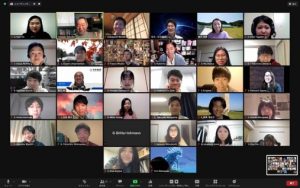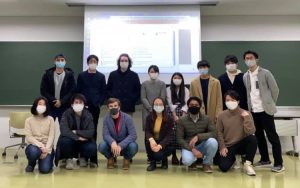3-day Workshops of “Design Thinking for Your Creative Practice” were held on 16, 23 and 24, January, 2021.
・Course Group: Leadership, followership and Consensus Building
・Course Name: TAL.W502-02 Fundamental Group Work for Leadership I (F)
・Program Name: 3-day workshop of “Design Thinking for Your Creative Practice”
・Facilitators:Thomas Both and David Janka (d.school, Stanford Univ.), Scott Witthoft (The University of Texas at Austin)
・Date & Time: Day 1: 16/Jan/2021 08:30-13:00
Day 2: 23/Jan/2021 08:30-13:00
Day3: 24/Jan/2021 08:30-13:00
During my undergraduate years, I had seen the announcements of “d-school coming to TokyoTech” several times and every time I saw the poster, I always said to myself “I’ll participate this time”. Somehow because of forgetfulness or schedule conflict I wasn’t able to join previously. However, I finally got to participate this time, in January 2021, Q4 of my master’s 1st year and I’m fully satisfied with the experience.
Three amazing facilitators: Thomas Both, David Janka and Scott Witthoft lead the 3 days of workshop from the US via Zoom. Even though the online courses and workshop can’t replace the in-classroom feeling and face-to-face interaction, after a warm-up exercise led by Scott of pulling each other out of the screen, it really felt like we’re in one studio and that feeling continued for the rest of the workshop. Each day had great ice-breaking creative exercises to connect us.
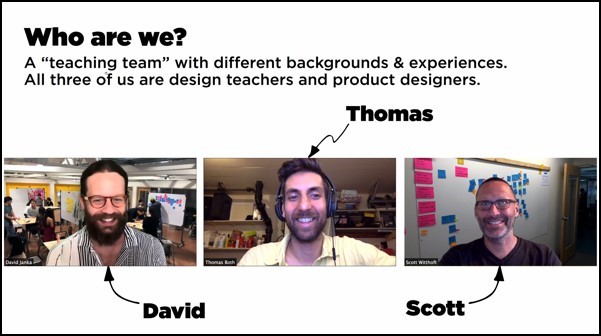
Day 1.
The first on our agenda was sketching (to be specific, sketching people) with Scott, where he talked about the importance of visual communication and simple yet powerful advices on handy tools and tips. When I first heard sketching, I was little worried since that’s not what I’m very confident about. However, he helped everyone to find the style to draw a person which we’re most comfortable with, and I quickly realized that sketching is not very complicated thing, yet strong tool for effective communication.
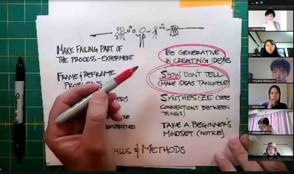
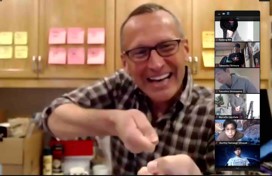
After a break, we started another activity: beginning by sharing our personal fascinations with another classmate. By sharing our fascinations, I got to know the other person better and I even got to find the person who is passionate about what I wanted to learn. However, who knew this activity of sharing our fascination was related to the banana we were asked to prepare beforehand: we were asked to create a promotion poster for a “BANANA” using our fascination. At first it seemed ridiculous, but actually after taking some time and thinking about it, it seemed easier. In short time, I made two plans: one using pictures from internet as background for my banana photoshoot, one outdoor banana photoshoot with my neighbor’s tree!
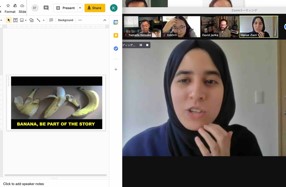
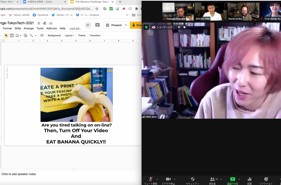
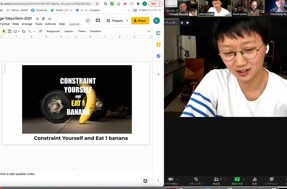
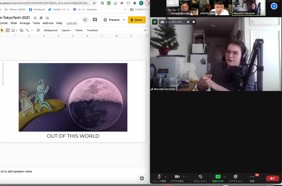
Then we came back to our Zoom room and shared our masterpieces with each other. I was thrilled with seeing others’ idea and how their fascinations were reflected in their banana ads.
As for the last part of the day, we practiced observing using different frameworks. It was surprising to see how we observe and extract information from a single image using different methods. After the practice, we got the homework to do observation fieldwork twice during the week, using different methods and focusing on the act of “carrying”.
Observation Fieldwork
I chose McDonalds in front of TokyoTech campus as my fieldwork spot. The first one-hour observation session seemed quite long, but thanks to the clear instruction on dividing the session on each observation framework, one hour passed quickly. The next day, I came back to the same spot and did my observation for 40 minutes. This time reflecting on the previous experience, I chose my seat on the second floor and narrowed down my view, which made my observation much better.
After two observations, I could see clear improvement on my sketching, taking notes and I felt more comfortable with the observation experience.
Day 2.
Continuing the Sketching Possibilities with Scott, we played with simple shapes to sketch objects. Then following our observation fieldwork, we shared our experience and findings in a group. After sharing, we practiced the design skill synthesis based on our observation on “carrying”. In a team, we extracted a set of findings consisting of the most interesting ones from each person, and practiced typologies, spectrum mapping, and opportunity statements.
These frameworks helped us to make the meaning out of what we’ve seen, translate them and see the opportunity to make the act of carrying more convenient and interesting.
Then we moved on to a short lecture about radical ideation and discussed how we generate ideas and do brainstorming effectively in a group. Following that, we had a chance to practice and use the techniques of mind mapping, brainstorming and adding constraints and selecting ideas in a group on topic of Olympics: (i) What is the Olympics about? (ii) How might we use the Olympics as an opportunity for university students?
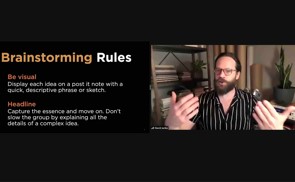
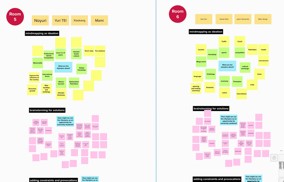
It was very interesting that even though there were some common ideas and perspectives on each question, there were some unique ideas from my teammates, which I hadn’t thought before.
Day 3.
We started the day by discussing the TED Talk by Doug Dietz, who shared his experience of transforming the GE MRI experience for kids. The story itself was very touching and what he did was amazing. From the video we could see the design skills and methods he used starting from noticing the issue to finding a solution.
Next, we watched a video about Kobe Shimbun Earthquake Project and practiced reframing problems using “How-Might-We questions” and “Why-How ladder” methods on what we’ve seen in the video. The “Why-How ladder” helped us to go deeper to understand the more abstract purpose and more concrete solutions. Going up the ladder, we ask “why”, which helps us to see the bigger picture and understand the meaning of the issue. Going down the ladder, we ask “how”, which helps us to see the possible solutions to contribute to the meaning we’ve discovered in upper part. Sometimes we tend to get stuck with one single solution, not being able to see other possibilities. When I learned “Why-How ladder”, I instantly remembered those experiences of feeling stuck, and it seemed like a valuable tool to find the abstract meaning and trace down possible concrete solutions from there.
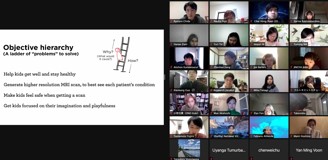
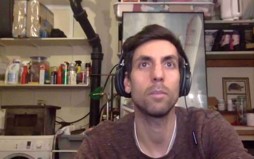
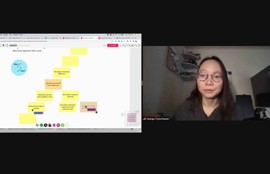
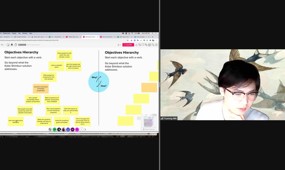
Continuing the topic of natural disaster, in the next activity we were asked to prototype a solution for a family during a wildfire disaster. This last exercise required various skills we learned during the 3 days of workshop: observing, framing the problem, brainstorming, selecting ideas, sketching and prototyping.
At last, the 3 days’ workshop ended with the most creative and effective reflection session on Mural, the platform we’ve been effectively utilizing during the workshop along with Zoom.
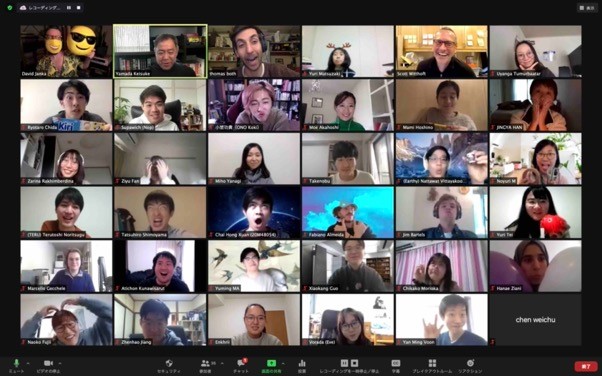
What I enjoyed the most is that the themes and exercises were interconnected, and we were able to practice the skills and methods we learned continuously throughout the workshop. Personally, I don’t feel very confident with the design and creative process, however with the tools I learned here and thanks to the 3 amazing facilitators, I felt comfortable and became confident that I can be a “designer” too.
With Thomas, Scott, David and energetic students from TokyoTech and other universities, great music by DJ David, it was the best “online” workshop experience. I wished that I participated this workshop earlier, but better late than never, I’m glad that I got to participate this workshop finally. I’m already trying to make some habits out of this workshop, such always keeping “new idea notebook” and writing tools with me, using “What, How, Why” to observe situations. I’m sure that I’ll utilize the various other ideas and handy methods in my research and other future projects.
Written by: Tumurbaatar Uyanga, M1, Energy Science and Engineering Graduate Major, Dept. of Transdisciplinary Science and Engineering, School of Environment and Society, & ToTAL 2020 student

